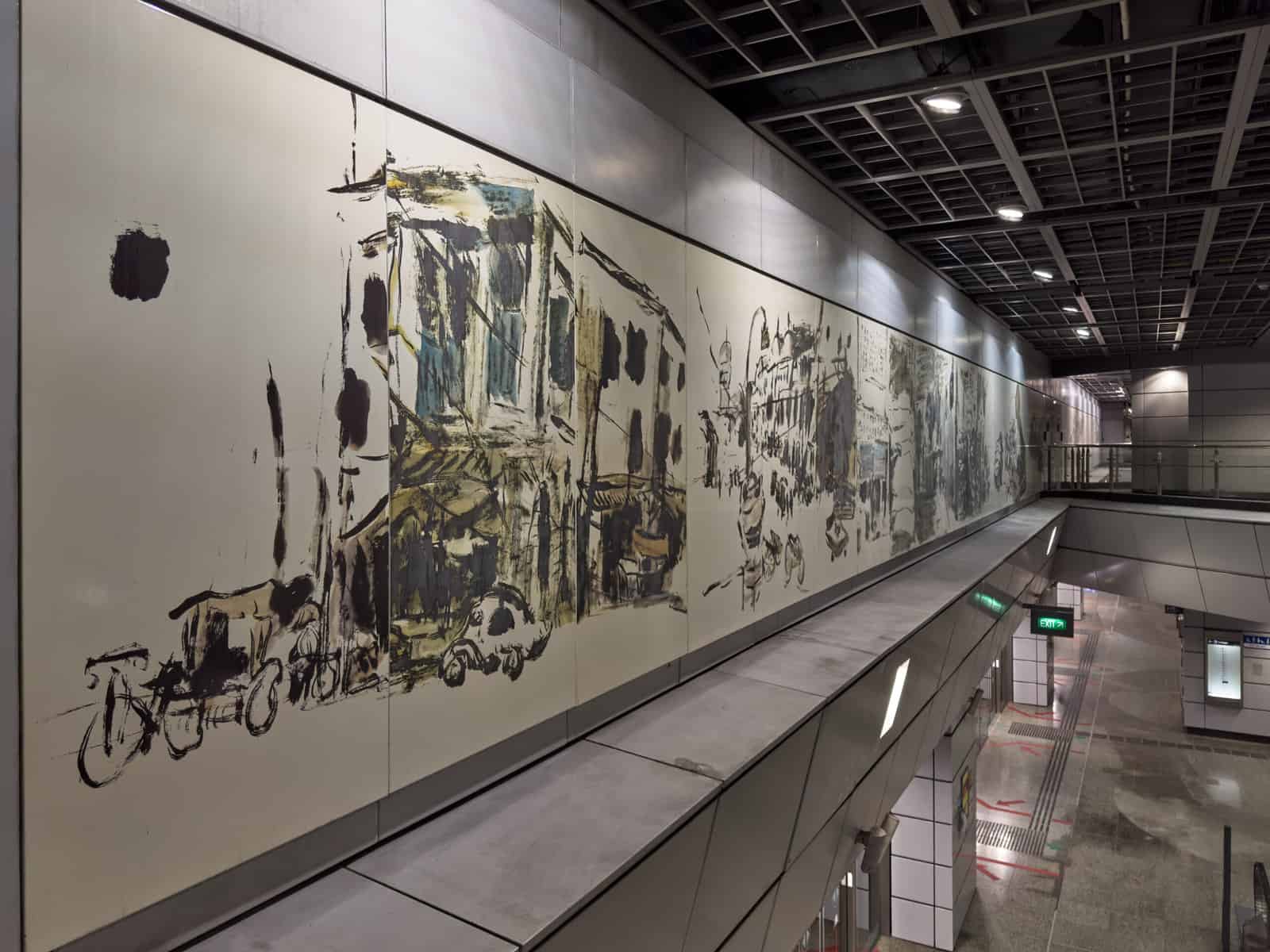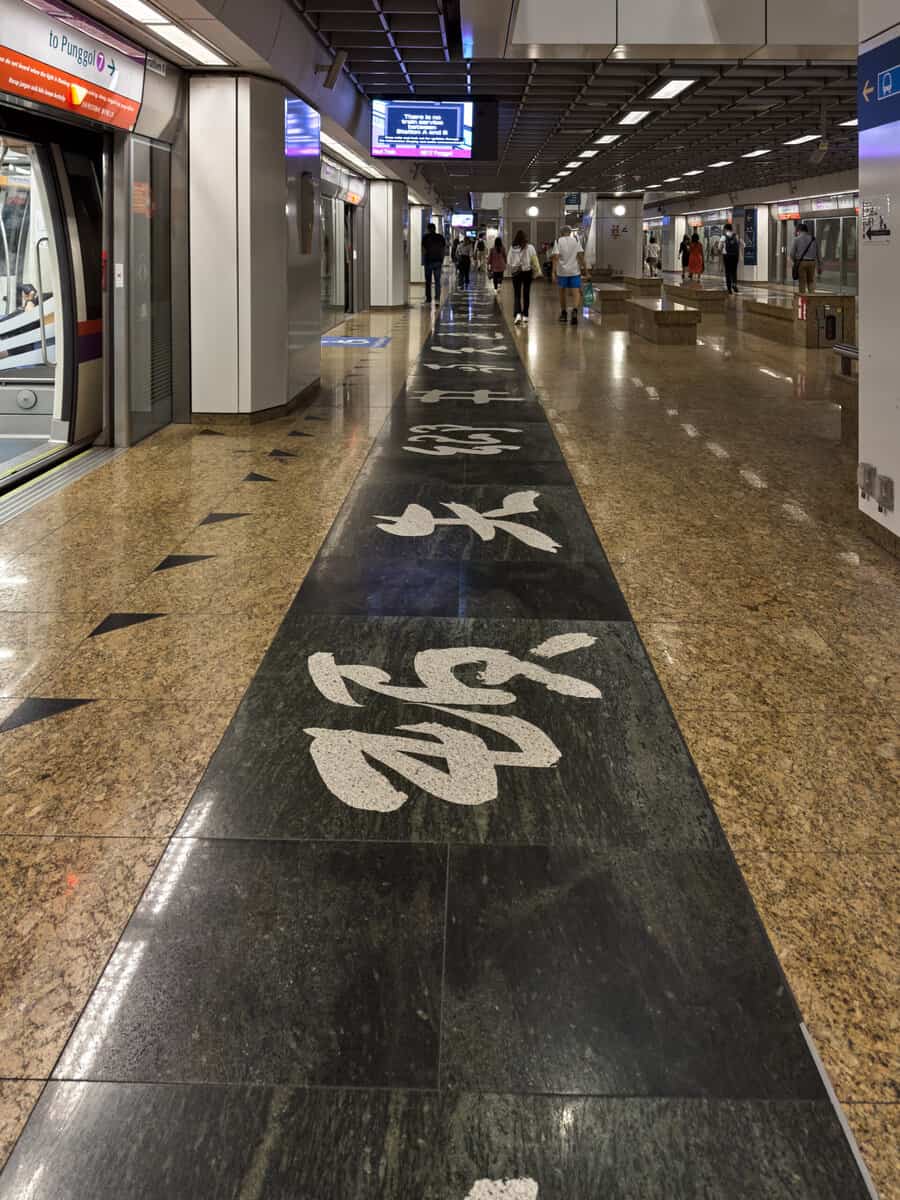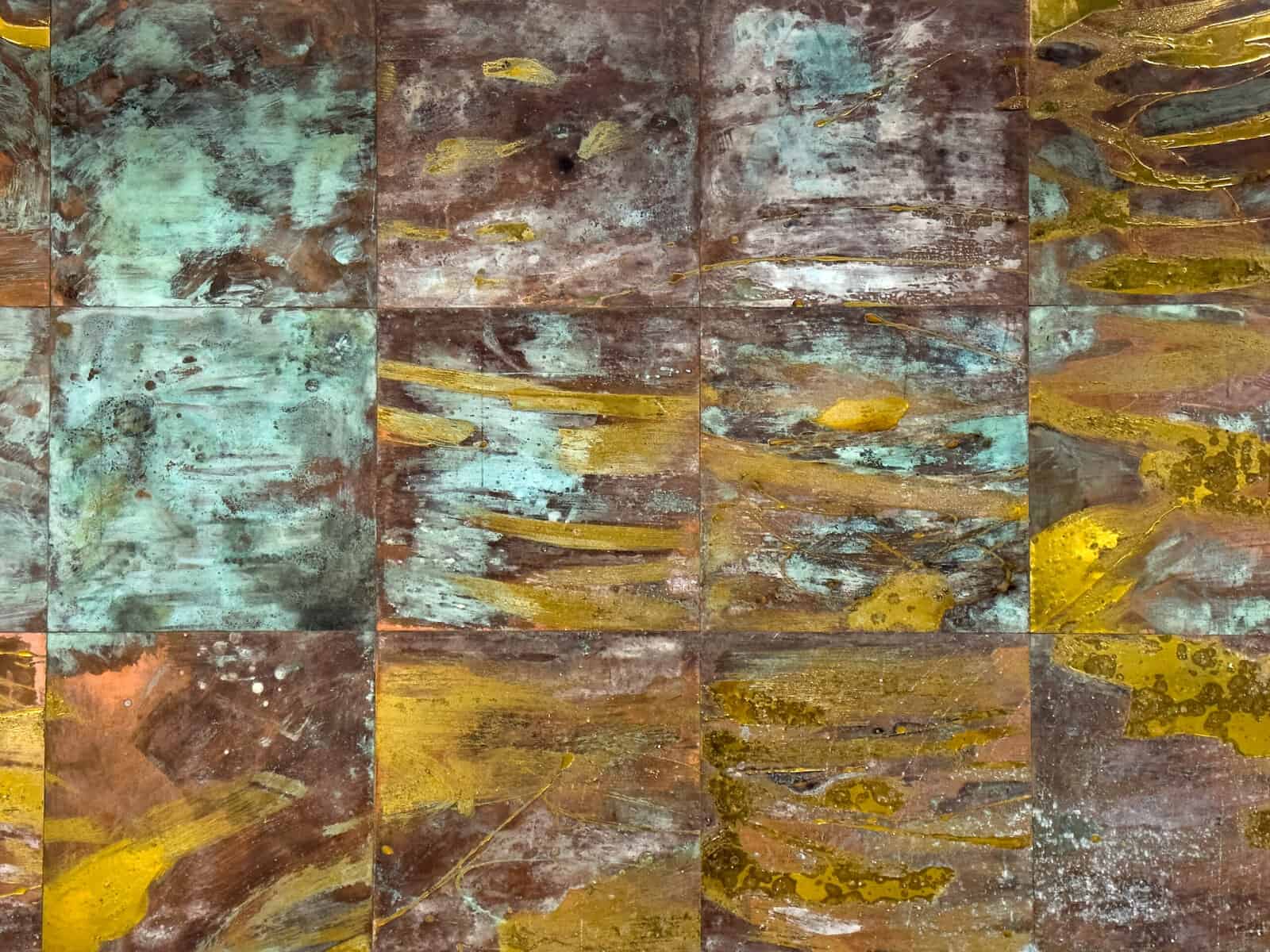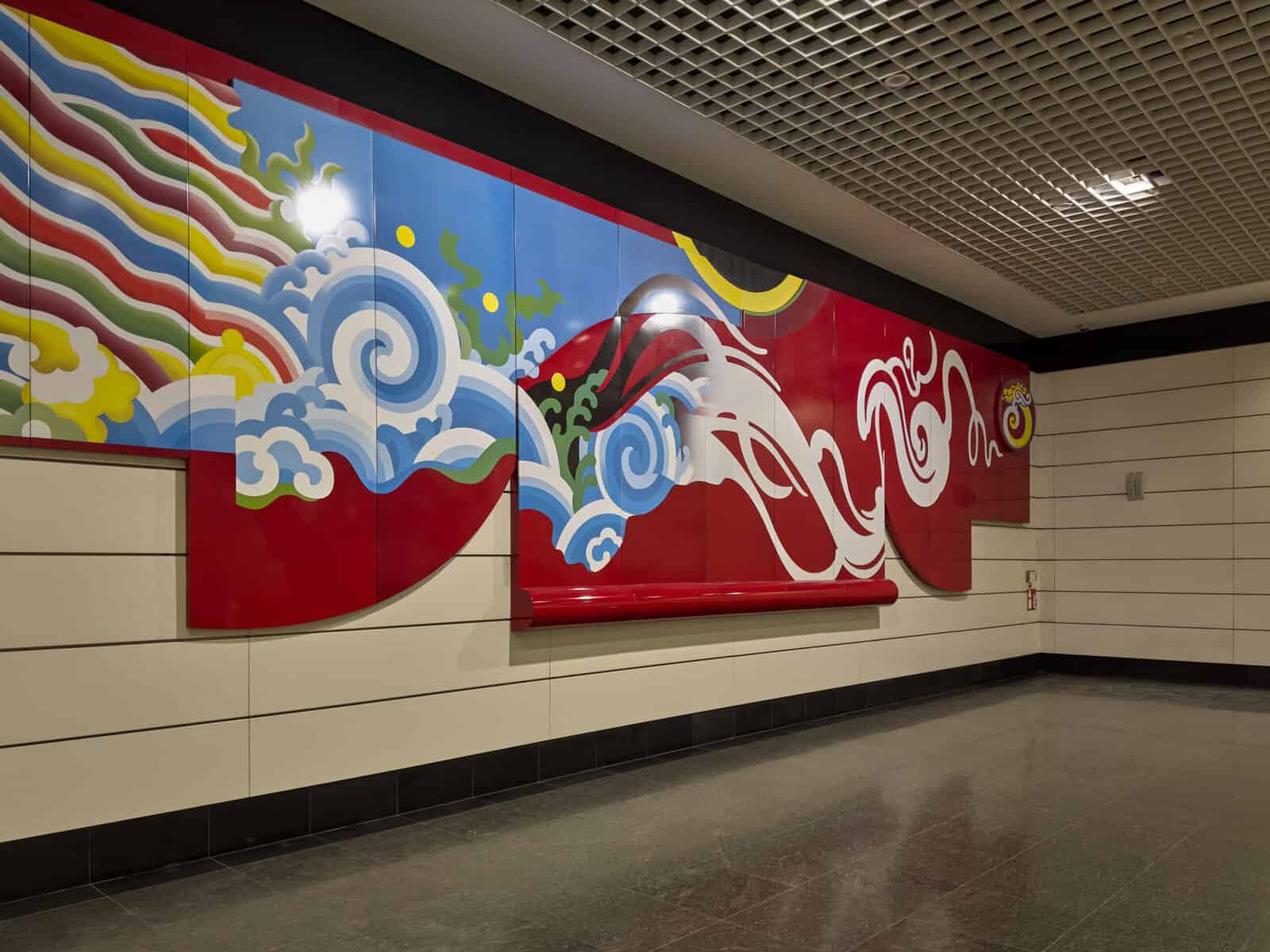Over a week ago, I had a complete change of pace from my usual brisk walk overtaking fellow commuters and running through the doors of Mass Rapid Transit (MRT) trains, when I joined a tour by Art Outreach Singapore (AO) to four MRT stations on the North East Line to take a closer look at the art in the stations.
Only ever glancing around me while waiting on the station platform or when I’m not rushing from one place to another (which rarely happens!), the short tour was a little adventure to learn about how our artists reflect on and interpret Singapore’s culture. This included insight into the overlooked aspects of balancing art-making with the practical purposes of MRT stations, and the artistic processes and collaborations behind the construction of the stations and artworks.
What’s in a tour?
In 2004, the Land Transport Authority (LTA) donated maquettes and models of the artworks commissioned under its Art In Transit (AIT) Programme to AO for the non-profit organisation’s annual auction. The buyers of these prototypes started requesting to see the actual full-scale works in real life, which led AO to conduct informal tours to visit the artworks in MRT stations.
In testament to its popularity, these evolved into formal public tours visiting various MRT stations in 2008. They took place rather frequently before COVID-19 struck in 2019 but were mostly conducted on a commissioned basis or upon request. The edition I attended featured the Dhoby Ghaut, Clarke Quay, Chinatown, and Outram Park stations. The tour was aptly held in conjunction with this year’s Singapore HeritageFest, which explores Singapore’s sporting and transport culture and history.
Congregating in the relatively empty foyer outside Plaza Singapura at 9:50 am (rather early for a 20-something-year-old on a Saturday morning), I was greeted by Mae Anderson, the Chairman of AO; Eve Hoon, Director of Programmes and Partnerships; and General Manager and Chief Creative Colin Wan. Anderson, who’s been personally giving the tours since the programme started, co-led the tour with Hoon that day. The duo tag-teamed from station to station; while Wan did what he does best—taking pictures and videos to support the team.
Sharing the load with Hoon, Dina Nerina, AO’s Community Programmes Manager, co-leads the tours with Anderson during other sessions. The tours are a team effort by the organisation’s lean team.

Immediately engaging with participants as we waited to start the programme at 10 am, Anderson took note of the people in the group, especially the children, knowing that she had to engage them with extra enthusiasm and energy. The charisma and confidence she exuded conveyed her experience with and passion for the works. She shared anecdotes and insight on the art; and more intriguingly, snippets of the process of conceiving and planning the works.
Hoon graced the tour with a quieter presence but with similar poise. Her eyes shone warmly as she spoke about the works with vigour, captivating participants by directing them to specific elements and sharing more about her personal interactions with the artists.
Experiencing the works in full-force
The values of connecting and storytelling tied the tour’s works together. These works embodied the history and culture of the MRT stations and of the people that previously occupied and continue to occupy these locations.
Initially, I wondered if these tours should be conducted during off-peak travel hours when there are fewer people milling about. But as the tour progressed, I realised the value of experiencing the works amongst the tides of people in the stations. Encountering the works as they were meant to be—in the stations surrounded by people—was meaningful, as MRT stations are literal places of exchange where commuters converge from different destinations and diverge to others.
In a way, our MRT stations mimic Singapore’s history as a trading port where people from different countries and cultures stop over for business before departing for other destinations. It also echoes Singapore’s status as a renowned global hub.
To me, the way Singapore has become so interconnected with its complex, intertwining MRT networks reflects the way in which different communities live and operate alongside each other.
Thinking about language and connection at Dhoby Ghaut
Interchange (2002) by Milenko and Delia Prvacki, a husband and wife duo—the perfect example of union and collaboration—captures this weaving of cultures by combining the artists’ personal practices and respective knowledge of mosaics and ceramics. Offering a visual contrast, Delia’s ceramic panels overlap and collide with Milenko’s mosaic tiles as the work curves over a wall.

The concept of cultural exchange also ties in with ideas of communication and language, as in Sun Yu-Li’s Universal Language (2003). Here, Sun draws from primitive art and incorporates drawings to overcome language barriers.
Spanning glass tiles, etchings and mosaic works featuring drawings of hunters, animals and dancers, Sun’s work adorns the columns, walls, and floors of Dhoby Ghaut station. These compositions help commuters navigate the complex and rather confusing MRT station, which has numerous exits. This exemplifies the practical function that these AIT works often serve: wayfinding, with forms and figures subtly directing commuters to where they need to go.

Storytelling at Clarke Quay and Chinatown
Other works saw artists use the MRT stations as canvases to reflect on Singapore’s past growth and future. Tan Swie Hian and Chua Ek Kay both cleverly use the power of visual storytelling to depict how Singapore has evolved over time.
Particularly interesting is the relationship between Chua’s works and Tan’s The Phoenix-Eye’s Domain (2003). The works were featured back-to-back in the tour, with the traditional Chinese painting style of Chua’s mural at Clarke Quay station juxtaposing with Tan’s illustrative mural at Chinatown station. Both works told stories of Singapore’s progress and the artists’ wishes for Singapore’s future, but through very different visual interpretations.


Both stations also feature unique compositions across the platform’s floors. To complement the main mural, Tan wrote a set of Chinese calligraphy couplets, which can be found on the ground. By intentionally placing words on the ground, he questions the way people treat knowledge and literacy by observing the way they move over or around the words.

Over at Clarke Quay, the platform features a work specially created by the station’s architects. Inspired by how Chua interpreted the Singapore River in the form of a brass-based work outside the station’s gantries, the station’s architects decided to include an etching of a scaled map of the Singapore River, highlighting the meandering roads and the bridges built over it.


Another special characteristic of Clarke Quay MRT is the station’s grey tones. Chua’s works and practice compelled the architects of Clarke Quay MRT to stray from the usual brown colour scheme used in MRT stations to complement Chua’s use of Chinese ink in his mural.
Work for the people at Outram Park
Lastly, at Outram Park MRT, the artworks celebrate the people that pass by and use the station, as well as those who used to inhabit the neighbourhood. Wang Lu Sheng’s Memories (2003) borrows from the props of Chinese opera, which was the main form of entertainment for the Chinese migrants that resided in Outram before its urban redevelopment in 1966, and transforms them into modern visual representations of the experiences and sights of the past.
Wang reimagined the robes worn by leading figures in Chinese operas into a large sculpture in the mezzanine on the way out of the station. Breathing a “modern aesthetic” into the traditional motifs, Wang’s aim was to add to Singapore’s visual vocabulary and echo its unique blend of cultures.

In another part of the station, Teo Eng Seng depicts the people who use the MRT station in Commuters (2003) by covering the station walls with 69 concrete impressions of people that seem to be moving in and out of the surface, presenting the station as a liminal space that people pass through on their journeys.

The bigger picture
The artworks in MRT stations offer commuters ways to consider our places in life, prompting us to think about those who came before us, the ground that we walk on and the stories that we are a part of. The tour of the four MRT stations by AO ignited a curiosity in me to be more present and mindful of my surroundings as I embark on my daily commutes. The AIT programme not only enlivens the physical spaces of the MRT stations but also creates an important point of contemplation amidst our daily hustle and bustle.
____________________________________
Art Outreach’s tours for Singapore HeritageFest 2023 have ended, but you can check out a virtual tour here.
More information on the works in MRT stations and the tours can be found on the AIT webpage by LTA.
Singapore HeritageFest 2023 runs till 28 May 2023. Click here to find out more about their programmes.
Feature image by Colin Wan. Courtesy Art Outreach Singapore.











